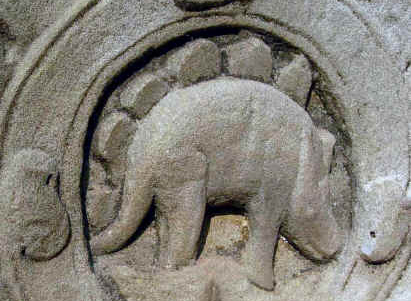|
Its Tail
The the tail of the creature above droops
down and away from its body, and may even touch the ground.
It does not appear to have spikes on the end of its tail:
perhaps because the end is not pictured (?).
Its Back
The creature above appears to have large structures or plates across the top of
its back. Its back also is rounded like a
ball.
Its Eye
The eye of the creature above is near the middle of its head
Its Head
The creature
above has either long pointed ears, or a frill (or shield) around the
top of its head (?)
Its
Legs
The creature above has a legs that are similar to that of an elephant.
Its legs are also larger in diameter than the base of its tail.
Its Claws
or Hands (?)
The creature above does not appear to have claws or hands on its
legs, and it appears to be walking on the ground (?).
|
Its Tail
The tail of the Chameleon above is pointed straight behind its
body. It does not appear to have any spikes on the end of its
tail; however this could be because the end of its tail is not in
the picture (?). Its
Back
The back of the chameleon is slightly rounded, but does not appear to have any
plates on it (?). Its
Eye
The chameleon's eye is near the top of its head and appears to be
pointing upward (?). It
Head
The Chameleon above does not appear to have a frill around its head;
however, it may have ears that are pointed backward (?). Its Legs
The Chameleon's legs are long and thin, and are smaller than the
base of its tail. They also appear to be smaller in proportion to its
body size than that of the creature to the left. Its
Claws or Hands (?)
Like the Chameleon on top, the one above also has claws or hands (?) that
can grasp a limb.
|
|
Its Tail
The the tail of the creature above droops
down and away from its body, and may even touch the ground.
It does not appear to have spikes on the end of its tail:
perhaps because the end is not pictured (?).
Its Back
The creature above appears to have large structures or plates
across the top of
its back. Its back also is rounded like a
ball.
Its Eye
The eye of the creature above is near the middle of its head
Its Head
The creature
above has either long pointed ears, or a frill (or shield) around the
top of its head (?)
Its Legs
The creature above has a legs that are similar to that of an elephant.
They also do not appear to be as flexible as that of the chameleon (?).
Its legs are also larger in diameter than the base of its tail.
Its Claws
or Hands (?)
The creature above does not appear to have claws ( or hands) on its
legs. It also appears to be walking on the ground (?).
|
Its Tail
The tail of the Chameleon above is slightly curved, and does not appear
to have any spikes on its end. Its base appears to be at least twice the
diameter as of its legs. Its
Back
The back of the chameleon above is slightly curved, and has small
ridges that are similar to that of the creature on the left; however,
they are much smaller, in proportion than the plates (?) of the creature
on the left. Its
Eye
The chameleon's eye is near the top of its head; however it is
slightly higher and larger in proportion than that of the creature to
the left. It
Head
The Chameleon above has ridges on the top of its head, and it also
appears to have a crest -- that is at least superficially similar to that of the creature on the
left. Its Legs
The Chameleon's legs are long and thin, and its front leg-joint is
so flexible that it is above its belly. The leg-joints of the creature
on the left do not appear
to be this flexible (?). Its
Claws or Hands (?)
The Chameleon above has three claws on its hind leg, and also appears to
be able to grasp a limb with both front and hind legs.
|



